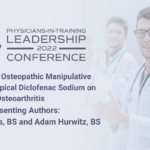Abstract | April 6, 2022
The Effects of Osteopathic Manipulative Therapy and Topical Diclofenac Sodium on Osteoarthritis
Learning Objectives
- Compare and contrast current methods of treatment for osteoarthritis.
- Identify the current gap in literature regarding Osteopathic Manipulative Therapy (OMT) and the topical NSAID diclofenac sodium use in conjunction.
Millions of Americans suffer from osteoarthritis; the chronic degeneration of joint surfaces. This degradation leads to pain, stiffness, tenderness, swelling, and soft tissue inflammation that significantly disrupts daily life. Definitive treatments for such a prevalent condition remain scarce. Currently recommended treatments include oral non-steroidal anti-inflammatory (NSAID) drugs which effectively reduce pain by selectively inhibiting COX2, an inducible enzyme active in the inflammatory process. However, the myriad of gastrointestinal side effects are a common drawback that frequently discourage chronic use. A recently accepted alternative is the use of topical NSAIDs like diclofenac sodium whose local action provides minimal systemic side effects. Osteopathic manipulative treatments (OMT) are another alternative without systemic side effects that have been in use for over 100 years. Common modalities employed with osteoarthritis include balanced ligamentous tension, facilitated positional release, and lymphatic drainage techniques but high quality clinical studies are lacking.
While osteopathic physicians frequently utilize OMT for osteoarthritis pain, allopathic physicians regularly prescribe topical NSAIDs like diclofenac sodium. The literature lacks robust evidence for osteoarthritis pain improvement upon usage of diclofenac sodium gel or OMT individually, and there are no studies available testing combined efficacy. This scoping review aims to further analyze the current literature available regarding these topics individually for osteoarthritis. Studies assessing the effects of topical NSAIDs or use of OMT on osteoarthritis of the elbow, wrist, hand, knee, or ankle joints which are the FDA approved joints where diclofenac has been shown efficacious have been included. The results of this scoping review will be used to guide our future prospective study focused on assessing the potential for combined effects of OMT and diclofenac sodium gel to improve patient outcomes. This study will employ control, OMT and diclofenac groups individually, and a combined OMT and diclofenac group. The trial will measure pain reduction and longevity of the different treatments. With these results, this initiative hopes to positively impact the large population suffering from osteoarthritis.
References and Resources:
- Argoff, CE. “Pharmacologic management of chronic pain” Journal of Osteopathic Medicine, vol. 102, no. s9, 2002, pp. 21-21. https://doi.org/10.7556/jaoa.2002.20012
- “Osteoarthritis.” Mayo Clinic, Mayo Foundation for Medical Education and Research, 16 June 2021, https://www.mayoclinic.org/diseases-conditions/osteoarthritis/symptoms-causes/syc-20351925.

